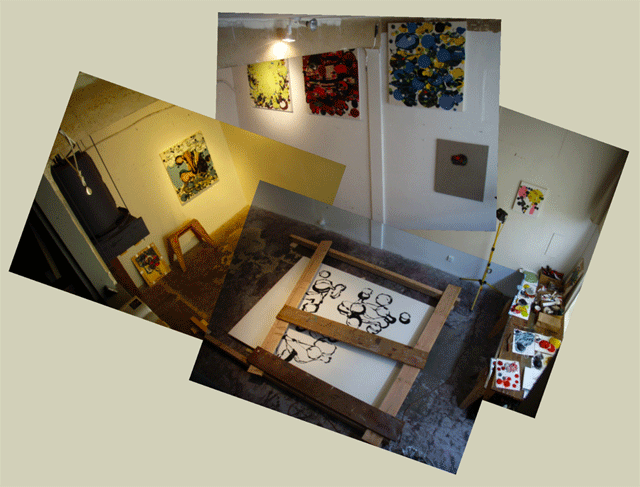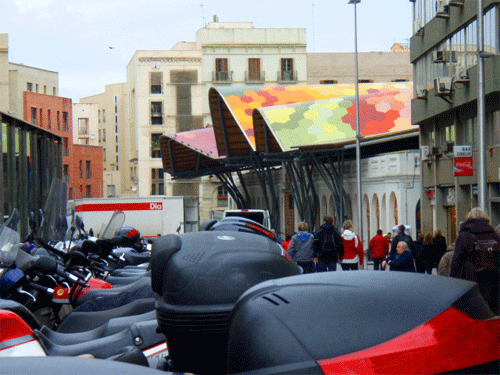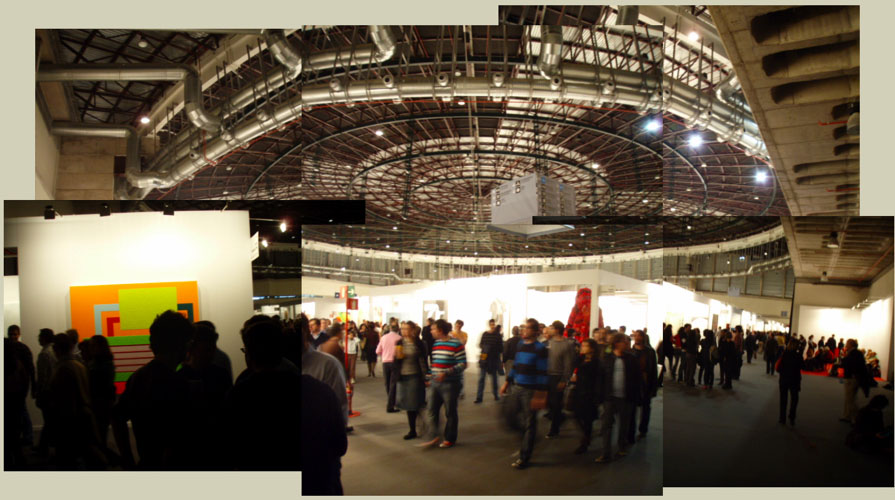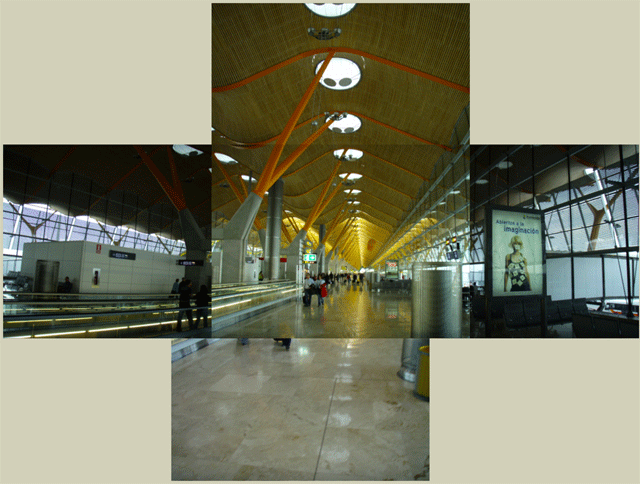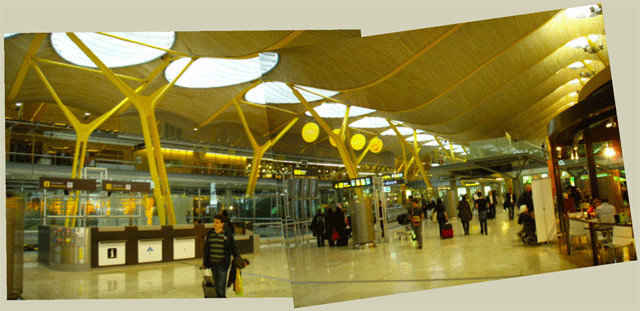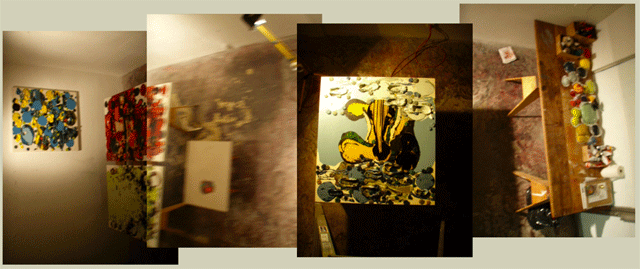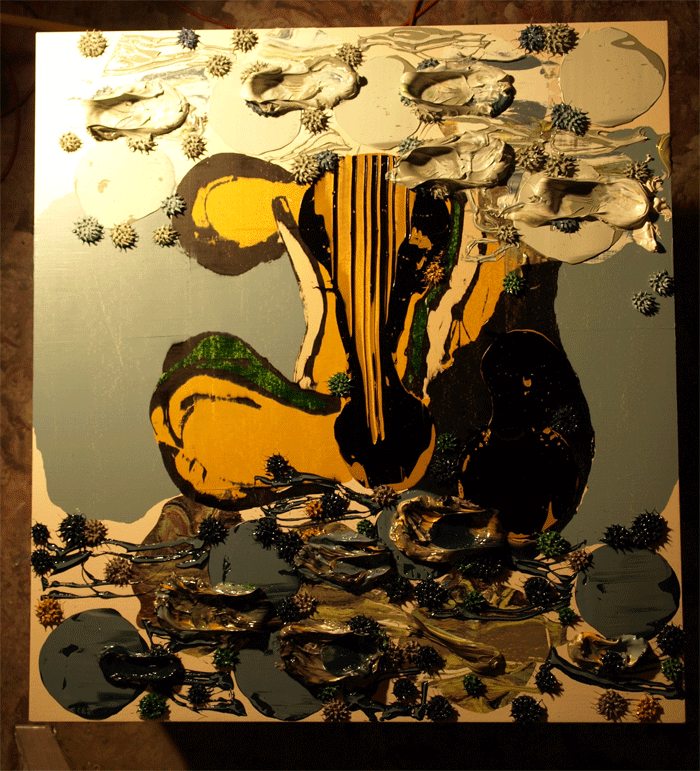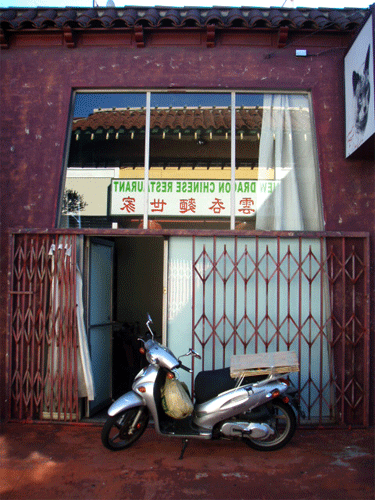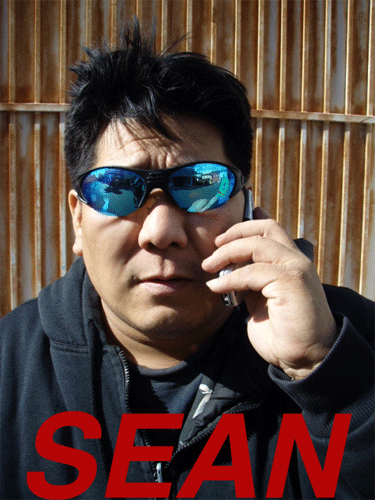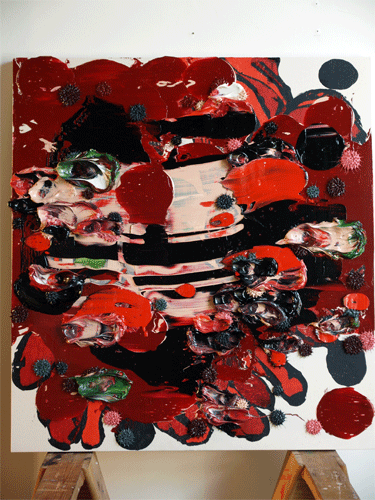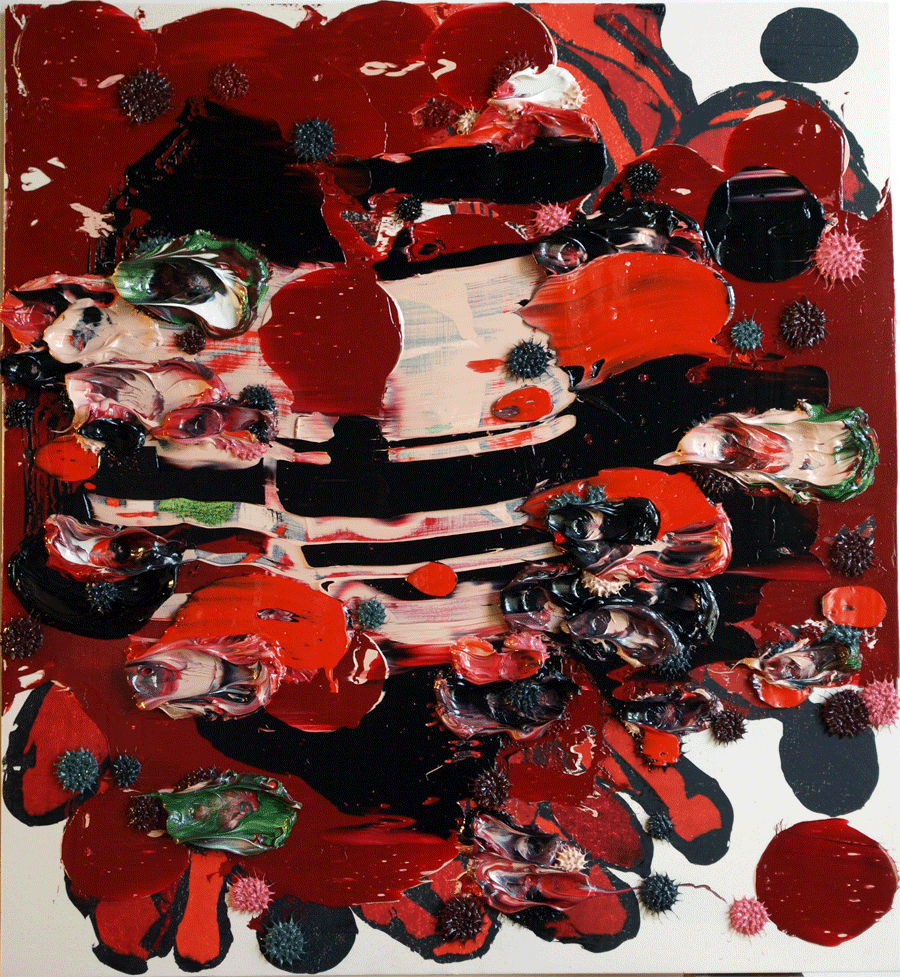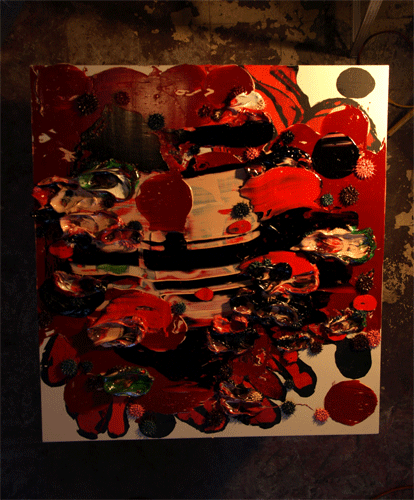February 29, 2008
February 27, 2008
Bart Exposito
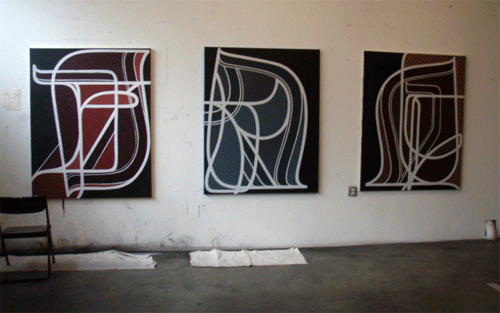
One of the great aspects of ChinaTown is the community of artists, and the ability to easily stroll over, drop in the studio and talk about what's going on. This is the working wall of Bart Exposito's studio and he's been moving through several evolutions of his work recently. What you see here is a dark turn (obviously), something new for him. The painting to the left is in progress, the other two are done. A previous body of work had him in lighter colors and paintings that tracked the qualities of the preparatory drawings that has long been an integral part of his practice.
Unfortunately, Bart is hard to pin down for a video interview. We have great conversations, very deep in the painter's realm (not all artists can go there) and I hope to flip open the camera one day and capture the butterflies. But for now, these jpegs will have to do. Here are a couple more close-ups...

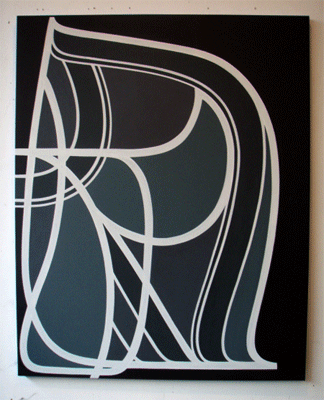
February 24, 2008
Christine Strueli at Mark M?ller in ARCO
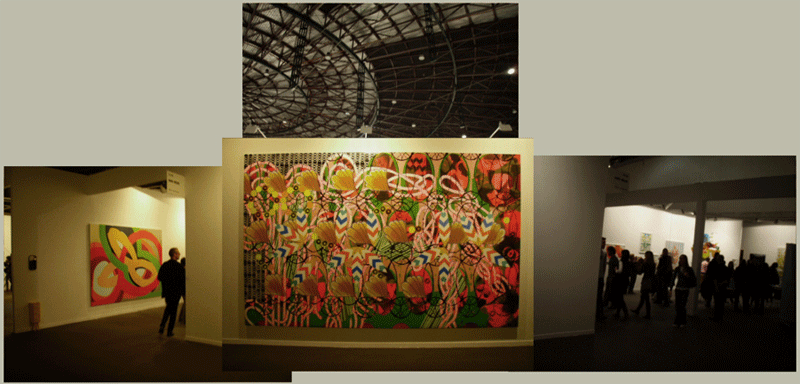
Christine's doing well over in Z?rich lately.
That's Markus Weggenmann's work to the left. I hear he has moved to Berlin recently.
Here's part of the interior of Mark's booth:
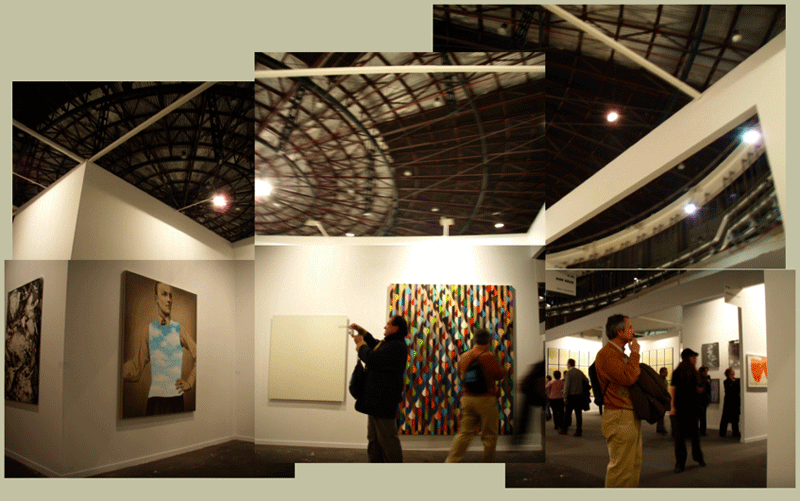
BCAM Bumped
(Admin note: I bumped this post to the front once I was able to finish it during my recent travels. I don't know about this guest blogger feature thing that I had initially agreed to... Ultimately I suspect that I may not be cut out for the role of traditional reportage since this piece has been completed so long after the news cycle has past. News isn't news if it's old news, isn't it? Many thanks to the Glasstire folks for the opportunity.)
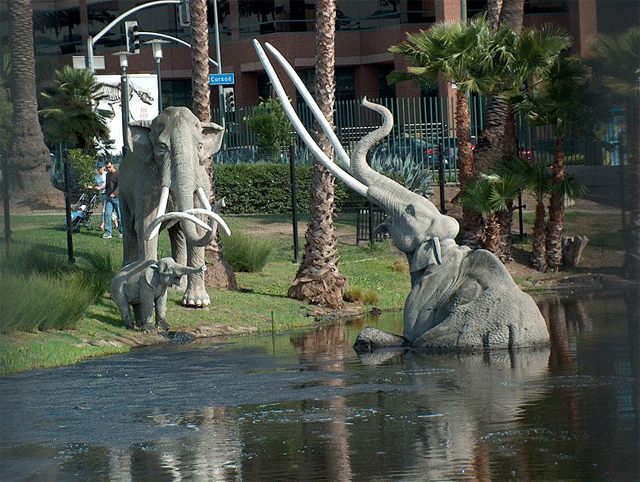
I'm not sure exactly why Ed Ruscha wanted to burn the LA County Museum of Art. But I sense a kind of boggy mire that must come from the inevitable bureaucratic entropy inevitably associated with the grand and otherwise distinguished cultural institution that is Southern California's civic crown jewel. Try as they might, there is always something... less than magnificent about the art complex that is LACMA.
Well, as I like to say: Bureaucracy is the natural enemy of art. (I've just added Penny Aphorism #12.) This must be the ultimate source of the creep of mediocrity that keeps LACMA from shining as bright as it otherwise should. "Good enough for government work!" Even with the monumental efforts of building BCAM (Broad Contemporary Art Museum), even one of the worlds truly great architects was eventually sucked into the muck of mediocrity which for me sadly calls to mind John Fante's famous line: ?you pretty town I loved you so much, you sad flower in the sand, you pretty town ...?
No wonder Eli Broad reserved the bulk of his collection for his private foundation museum.
(Eli Broad delivers opening remarks at the unveiling of BCAM, LA County museum of Art .)
I don't mean to strike a corrosive downer note over the feat and deed that is the manifestation of the museum "campus" (their term) of seven buildings, a prehistoric bog, a park and twenty acres. The harsh aspect of this critique arises from the laurels of achievement that LACMA has justly earned thus far and the ambition by which it is tasked. LACMA is a good museum and it has a destiny to be a great one. This is why it must suffer a ruthless assessment. (Insert sound effect: snap of the whip.) I think of exemplars such as the Smithsonian in Washington and the Metropolitan Museum in New York and and I would guess that it is the overwhelming force of a 230+ year democracy or the immense powerhouse that is New York City that helps these institutions achieve such an august stature and overcome the shabby curse of bureaucracy. So let this temper the harsh edge of this critique: Los Angeles is young. (I think LA is like a New York before the subway was built.) Despite the fact of California's high ranking in economic terms, there has not been an earnest reinvestment into infrastructure both practical and civic since the late sixties. In terms of diverse public/private partnerships that include British Petroleum, Target and Credit Suisse who participated in the creation of the LACMA campus, it bodes well as a example of what can and should be done in Southern California in the near future.
The particular contribution of the Eli and Edythe Broad collection is remarkable indeed. It is in fact a transformation of suburban wealth (Broad's Sun America and KB Home are both in the Fortune 500) into an extensive urban philanthropy. Indeed, the specific collection that Eli Broad is known for is so well done that the only critique that remains is that it appears all too complete, too much of a last word on the subject. Specifically, it is too complete in the telling of the story of the arc of the era known as postmodern art from Warhol/Ruscha to Koons/Hirst, the art of the 80's.
(Perspective alert: I see the development of art from the eve of the 60's to today as a forty year arc where art's mandate was to indicate everyday life through conceptual means. #2)
Therefore I find the various controversies over what Broad should or shouldn't have done with his property and his responsibility to Los Angeles or to the art world at large too tedious to track. The whole event is a great feat and a good deed, and everyone deserves an "attaboy" as far as I can see. But I did have high hopes for Renzo Piano's contribution and it was sad to behold the mire of the bog that for me has come to symbolize the whole evolution of the LACMA campus.
(Renzo Piano Opening Remarks BCAM LA County Museum of Art.)
Initially, I fell under Piano's charms with the opening of the Twombly museum in Houston. Free of the partnership with Richard/Sue Rogers that created the remarkable yet garrulous Centre Pompidou, the Twombly museum seemed to me to reflect a kind of elegance of tech that was closer to aviation engineering. His expression of technological systems was tempered by Occam's Razor, nothing was designed that didn't serve the purpose of the building both functional and existential. The tech was hidden, even... the roof layer was a multitude, a bristling and vibrant machine whose presence was indicated only by the quality of light in the galleries and the occasional upskirt glimpse tastefully delivered. The rest of the structure seemed eternal. Overtones of Egypt. It appeared to be a promise of art history delivered in stone, concrete, proportion and stately procession.
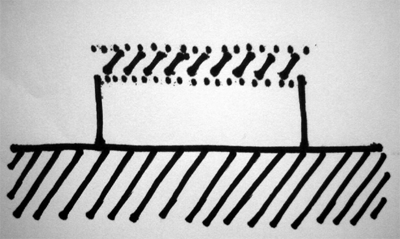
(Click to pop up the parti.)
And Piano became famous for his parti: the eternal gallery and the tech frosting; the veritable sky, the kind of firmament that only pilots know, delivered in ambient presence within his architecture. So as I sat in the audience listening to the unremarkable opening remarks, I wondered about Piano's parti and how he would handle three stories of it stacked atop one another. I had hoped that the two floors weren't generic. But how could he have done it? How could one deliver one floor of galleries to the sky and deny that sky to the others below? There would not be any participation in this expression, no aire de Antoine de Saint-Exup?ry's, no Renzo magic below the top floor because the signature Twombly parti can only go so far... like a magnificent yet doomed jet in a high speed turn... before it disintegrates in mid air.
I was hoping to be surprised, another page in the Piano book.
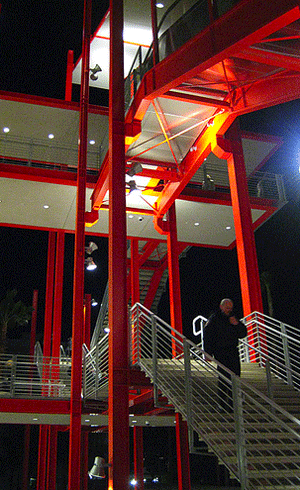
(foto: Dan Hontz)
The first sign of trouble was the escalator to the third floor, the primary entrance to BCAM. Literally with the hum of people mover machinery, it was a solution chasing a problem that didn't exist in the first place. It was a massive poker tell of a bluff. Walking up into the entrance and down into the building, my fears were confirmed. The floors below were indeed anonymous architectural genera, the kind of architectonic blather one sees in office parks, shopping malls or somesuch building types. It was a copy and paste architecture, a formulaic draw from a pull down menu of anonymous solutions. Only the ceiling height and general proportions referred to a museum gallery. But to be fair, perhaps this is sufficient to the task. After all, these are the only qualities that artists tend to want in an exhibition space generated by architects.
Like the turn away from formal expression that architect Frederick Fisher made in the middle of his career --he said that he wanted to become a "merchant of light and space"-- this was a song sung to the hearts of artists all over the world. Artists and architects are famous for not liking one another, remember Robert Irwin's famous face eating scene with Richard Mier in the PBS special covering the creation of the Getty campus? Artists would prefer that architects get the hell out of the way, to not constantly steal the show, all the while stealing away a proper context for the presentation of art. Architects fundamentally don't understand why artists exist at all since it is architecture itself that is the mother of the arts... and mommy dearest isn't happy when the kids aren't quiet and behaving nicely. But Fred Fisher wasn't the architect of BCAM and Renzo Piano isn't a self effacing, ego erasing Buddhist. Piano can only get into trouble if he creates genera in architecture. Piano has a specific vision, and this vision suffers when it is not attended to.
And then there is the "spider".

With the repeated flaccid references by Piano and various LACMA officers to the "spider" that is the circulation spine of the campus, there seemed to be an attempt to convey some kind of affection for the internal street that culminated in the escalator. It was as if they had to convince themselves and the public that the crawling walkway was the string that strung pearls. The creepy crawly name itself, the "spider", betrayed a lack of trust in the expression of the solution. Spiders spin webs and spiders eat what gets caught in them. All the red paint with which the "spider" was painted seems to be another solution chasing a problem that didn't have to exist in the first place. Perhaps the expenditure of 60 million strained the budget. Of course it did. Perhaps the circulation should have had a more robust presence. Yes. Perhaps the spindly sticks of I-section steel actually reflect the literalness of the characteristic line hatches of Piano's drawing style. Hell, yea. It was as if he had handed off airline cocktail napkin sketches to his lead designers as he zoomed off to the next fabulous client meeting (I recall I.M.Pei's famous generation of the solution to the National Gallery in Washington while flying coast to coast). It might have been better to evoke an urban street using paving stone, lighting standards, occasional seating, trees, vistas, crossings, water features (...since I am continuing this blogpost after a visit to Madrid, the Paseo de Prado/Recolctos/Castellana is what I am thinking of). But then again, what would all this have to do with the tech frosting that delivers the aire de Antoine de Saint-Exup?ry's?
Thinking of how to express other architectural features outside of the classic Piano parti prompts me to wonder how Renzo Piano could possibly extend his language beyond the tech roof systems that he is so justly famous for. Architects see buildings in terms of systems much like doctors do, in terms of nervous, digestive, circulation, and endocrine systems. Unlike his contemporaries such as Foster Associates who emphasize the extreme expression of engineering systems such as mechanical, structural and electrical, Renzo Piano focuses on broad systemic categories such as roof, wall, floor as the principal aspects of architectural expression which would normally contain the three engineering systems. Specifically, he has dwelt on the roof as an empire in itself, one bristling with the various subsystems meant to deliver the lens of light in the sky into the interior volume of the architectural experience.
My question to Mr. Piano: why not look into the other broad aspects of wall and floor systems for a capacity to do something similar to what you have done with the a tech thickened roof? Wall systems could become a lens which focuses and delivers the civic community. Floor systems could become a lens which focuses and delivers the earth and ecological context. Perhaps it is his genius that restricts his expression to the sky. Perhaps it is the central distinguishing aspect that separates him from his former collaboration in the Centre Pompidou, a move that broke him away from general techno-lust that obscures thousands of other architects.
Therefore, in commissions such as the BCAM, it is important to negotiate the two forces that prompted him to stack his signature parti atop two floors of genera: the need to enfront Wilshire Boulevard with an elevation that linked LACMA West with the rest of the Campus, and to clear the decks for the provision for underground parking and open green space that is the tattered remnant of the La Brea tar pits.
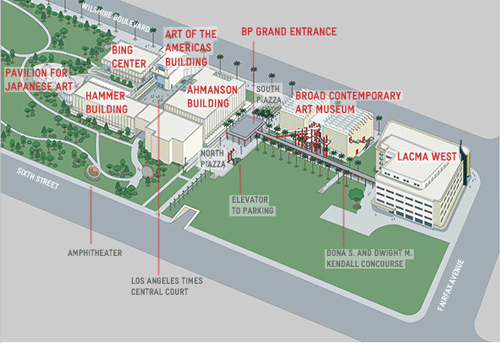
(Click and imagine spreading BCAM across the site like a hot butter knife.)
It's time to do our own design a la cocktail napkin. Let's imagine a Ranzo Piano solution that ties all these aspects together: A tall and narrow space that forms a facade on Wilshire, top that with a Piano tech frosting, flow the frosting in an angle to the north down toward the park and let that cover the rest of the program that is spread out over the former open space across the circulation spine, then tuck the parking under the whole program and then take the green space and feather that into the tech frosting in a way that merges people on foot into the Antoine de Saint-Exup?ry's firmament. Would it be possible to achieve a feeling of flying or floating as you approached the building from the park?
One can only wonder.
Madrid to Barcelona to Tossa
(Albertos' friend here in the video is a talented magician and mathematician (number theory) by the name of Cupper. A fine fellow he is.)
Sant Telm 2008
I was talking to my carpenter Ramon Gascon and builder Kiko Noguerra about details concerning some changes that we are making to our place in Tossa de Mar, Spain.
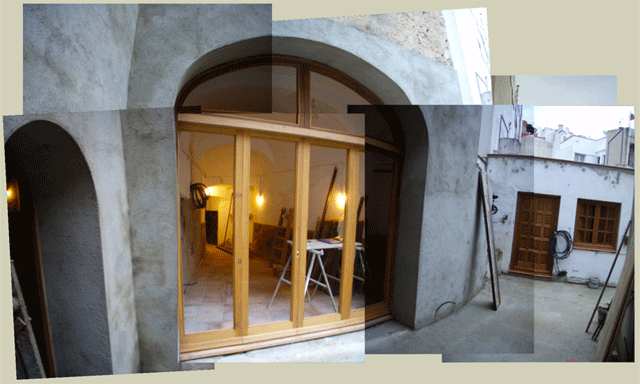
February 21, 2008
Ahora

Here are some quick notes before I board the plane:
-How was ARCO?
Good. It was my first time there, so I can only compare it to the other fairs. It is physically about three times bigger than Miami, perhaps 75% smaller than Basel. Economically, it is about 1/200th the size of the monster that is the Basel Art Fair. Miami's advantage for me personally is about all the parties, where the social networking is leveraged for maximum chat time (read: art talk of all types philosophy, gossip and business). I saw the lecture/symposium program at ARCO and it seemed better than what I've seen elsewhere but I didn't have a chance to visit any of them. Reports from my undercover agents are that they are worthwhile.
ARCO has evolved into a new level recently, blossoming into the international arena, its history being more about the internal art world in Spain than anything else. No more. I've heard that there are about 25 galleries from Spain that were shut out in favor of an international selection. I'm sure that they aren't happy about that. I heard also that there are many more collectors vectoring in from abroad too, welcome news in these parts.
Madrid. This was a visit where I am starting to feel comfortable with the city, familiar enough with it to get around in the excellent subway. I never took a taxi the whole time I was there. I only had time to visit the Prado, and my impression of what Raphael Moneo did to it was: MEH. He took the linear circulation plan and chopped it up, forcing people to loop in and out of it into it, destroying the feel of the existing building, interrupting the musty classicism with a strange plastic feeling pastel colored generic architectural addition that had no presence of it's own, it was a melange of generic walls, ceilings and surfaces. I'm beginning to think that Moneo is good only with clients who are dead, so he can wax elegiacally with masonry in compression. I'm thinking of his National Museum of Roman Art, a terrible thing to have your new work compared to your old work, isn't it?.
Oh well (pues, nada). At least he didn't utterly destroy the Prado.
Parties around town? Oh yea. I went out with young Alberto and his Madrillenio pals, so I didn't get to noodle into the meat of the art world society... which is good since I wanted to get a sense of the famous Madrid night life from the street level view. I had heard from one art world insider that the the cub to go to is call the "Cock Club". Cock, as in penis. Or fighting cocks, as in poultry? Probably not.
Oooh, so transgressive.
-How was Tossa de Mar?
The house is coming along great! It is a struggle to control the costs, but all the work is worthwhile given that our objective is to complete the transformation of a former restaurant into a home/studio and realize our vision of living both in Europe and the USA simultaneously.
I've got pics to post soon.
Folks in Tossa are wonderful as always. A sleepy town in the winter, much of the social life happens inside friends' homes, cooking great food, smoking and drinking until the wee hours. There were many wee hours spent this week. The conversations were fun, ranging from politics local and international to philosophy and gossip, personal stuff.. good stuff. It was good to show my face in the off season to remind the townfolk that I'm a local too.
The only problem: Bar Josep has undergone a renovation and the musty old man bar is gone and now all the walls are pink and a pink granite countertop has replaced the nasty wonderful varnished wood bartop and the doors and windows are painted brick red. And they have new surveillance cameras. Wuh.
Wuh, wuh, wuh. First the Prado, and now Bar Josep. WHAT IS HAPPENING IN THIS WORLD???
And Barcelona! Hell yea. I walked my butt off yesterday and I love getting lost in the city. The weather is starting to turn, you can feel the spring just around the corner. I stayed in a hotel off Princesa in the old part of town, not far from the Born. Wondreful, it was.
And the food! Well. Pan Catalan, fish called Rape, wine, wine, beer, chupitos, cortados, calamari, salsuelos, white beans, tapas, torillas, mejillones, octopus, berberechos, rabbit, paella, crema Catalan, cheese and honey, croissants, bikini bocadillos, chorizos...
Then, cigarettes: Camels, Winstons and Malrboroughs. Finally, one porrito I smoked with Nacho and Leslie. Ooof.
February 20, 2008
BCN to Heathrow to LAX
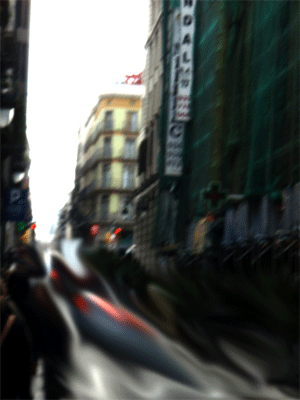
I'm just about to head to our other home in LA in a few hours. Lots happened, I'll have to scoop up the fotos and race a commentary on the fly as best as I can because I'll be hitting the ground running once I get back.
Stay tuned, more to come.
February 18, 2008
February 17, 2008
Wee Hours
Los horas de la madrugada (about 4am) in downtown Madrid, not far from Retiro Park.
February 15, 2008
February 14, 2008
February 11, 2008
Ahora

I'm thinking of the avalanche of painting to come, trying to get a grip on the quantity of paint I'll need so I can get my people at Roark to supply it on a just-in-time basis.
As you might have seen in this post, the show will be a combination of small and largish panels. The big panels will be 3- 7'x9' and the small ones will be either 50"x46" or thin alumino-luan panels at 36"x30".
truth, convenient and otherwise

Conventional wisdom has it that here in the states, the Democrats and the Republicans are at loggerheads. Not only does this not have to be this way but I believe that deep, deep down inside our national psyche, the contrary is more to the truth of the matter. Check out this article about the very interesting current state of politics in the USA at the moment:
A common thread runs through these four issues. Shooting wars and culture wars, immigration and the federal budget--all are examples of the Mick Jagger principle of governance: You can't always get what you want.

I think that when you look closely, very closely, one can see how the dynamic of torque works and that there is a promise if not the fact of the two grand parties working in concert. Remember the mnemonic knuckles of the constitution? Democrats have 2 knuckles and the Republicans have 3 but all five belong to the country as a whole.
We are whole, aren't we?
Back to the article, it's a good one:
Politicians have a limited array of governance tools available to them, and they operate in a world of constrained choices. Voters no doubt wish that the consequences of past policy errors--the Iraq invasion for Democrats, the failure to police the nation's borders for Republicans--could be wiped away. They can't. One part of the electorate believes that providing the best health care to all Americans is a moral imperative. Another part believes that the hundreds of thousands of abortions each year in the United States amount to a holocaust. No matter how passionately held, the first belief cannot make top-flight, universal, affordable health care a reality. Nor can pro-lifers' commitment, by itself, eliminate abortion. Wishing doesn't make it so.A sizable share of both parties' most passionate supporters seem not to understand that basic truth. "Yes, we can!"--so goes the shout that punctuates most Obama rallies. The audience may not realize it, but the spirit of those words is uncomfortably close to the spirit that led the current administration to fight a hard war with too few weapons and too few soldiers. Sometimes, leaders need to say: No, you can't. Problems aren't solved because voters, or the politicians they support, imagine the solutions.
Because these are Democratic-leaning times, Republicans have the most to gain from embracing this year's inconvenient truths--and may have a nearly ideal candidate to do the embracing. John McCain may be better positioned than anyone in either party to secure the southern border without alienating America's Latino population. He has a strong pro-life voting record, but has never been in the thick of the culture wars. On Iraq, McCain is prominently identified with Petraeus and the surge. Politically, he stands in much the same position today as Dwight Eisenhower in 1952: tough-minded and hard-nosed without being reckless--and, like Eisenhower with Korea, he bears none of the blame for the war's mishandling. On spending, McCain may be the country's leading proponent of fiscal discipline: Ross Perot without the lunacy. A McCain-led Republican party could become the party of deficit hawks--just when deficits are about to become the political liability they were in the 1990s.
The two Democrats seem less impressive on this score. Hillary Clinton and Barack Obama talk about border control the way children talk about eating their vegetables. As kids leave the table before the beans and carrots are gone, one suspects a Democratic administration might quit on border security before the borders are secured. Neither sounds much like a deficit hawk. And on the war--the real one--both have made statements that could make wise governance impossible if either reaches power. Political talk matters: It shapes voters' expectations and defines the political context in which decisions are made. Standing tough in Iraq may be impossible after voters have heard, again and again, that their new president is firmly committed to bailing out, as quickly as possible.
Sad to say, the candidate who most often tells unhappy truths may not turn out to be the candidate who wins the most votes. Elections are not always won by truth-tellers; deception sometimes carries the day. John F. Kennedy, whose presidency is often invoked these days, won a close national election by describing an imaginary gap between the Soviet Union's arsenal of missiles and our own. If something similar happens this year, if the next president wins by promising limitless spending with limited taxes or a costless retreat in Iraq, voters should not blame the winning candidate. In politics as in markets, customers rule; we usually get the leaders we want. The trick is to want the right leaders. We might start by asking who tells us the truth--even, or especially, when it hurts.
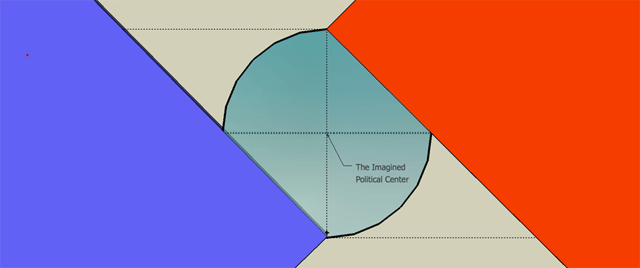
Top of Wikipedia: "In physics, a torque (τ) is a vector that measures the tendency of a force to rotate an object about some axis. The magnitude of a torque is defined as force times its lever arm..." ...and that lever arm is the distance from our political center, a place that ultimately can only be imagined but whose reality is the basis of civility and community. In physics you need less force with a longer lever arm, but it seems that in politics, the further one moves from the political center, there is a disturbing tendency to fly off into the ideological ether. It seems that in the political sphere, the lever arm becomes more brittle with length.
If our two parties could take each other's critiques seriously, to assent to the ultimate unity of our actions, we might be able to get some meaningful work done for a change. This is true for most antithetical ideologies not only the political ones inside and outside the states but also and especially in our art world between theory and practice, between the market and revolution, in urban planning as in my cherished hobby horse, Parallel Cities... get the picture? It's less important how things fall apart (postmodernity ended with deconstruction didn't it?), it's more important how things go together.
You say you want a revolution? Well, you know. We all want to change the world.
Try one with some torque to it. To do that, all you have to do is to get a grip on the imagined center.
Aluminum Stretcher Panels
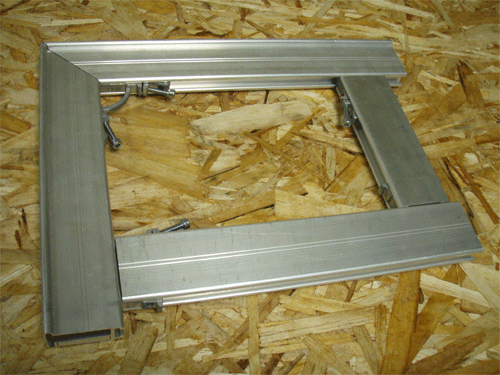
Friend and fellow artist/painter here in Chinatown, Phil Wagner has a part time gig manning a painter's stretcher bar shop called Alustretch. A company created by Peter Raich, he has established shops in Austria, Germany (Liepzig), England (London) and now here in Los Angeles.
Here's their contact information in Los Angeles:
Alustretch US LLC
400 Cypress Ave.
Unit C
Los Angeles, CA. 90065
323 343 8781
323 687 9001 Cell
p@alustretch.us
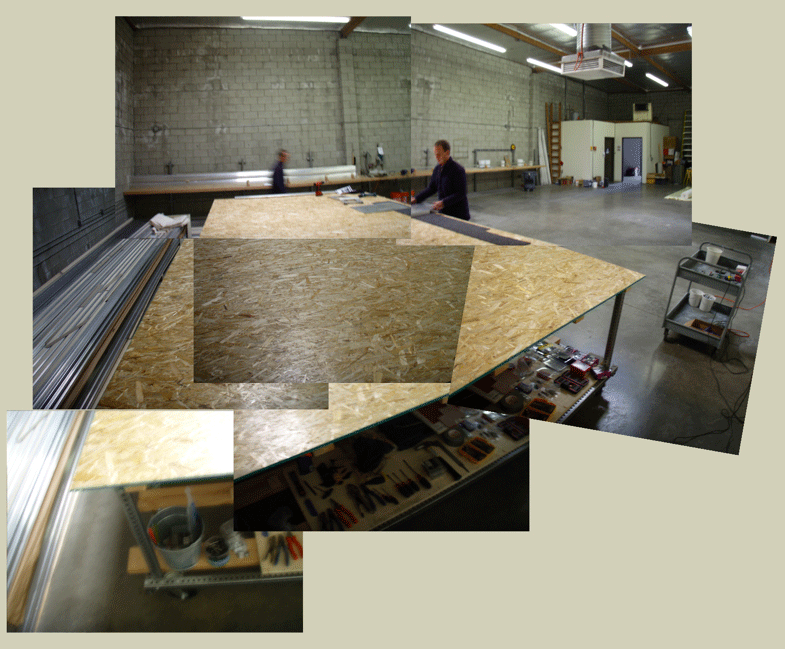
Peter has fabricated and refined an extruded aluminum stretcher bar in two sizes/types:
H27: 1-1/16"
H40: 1-5/8"
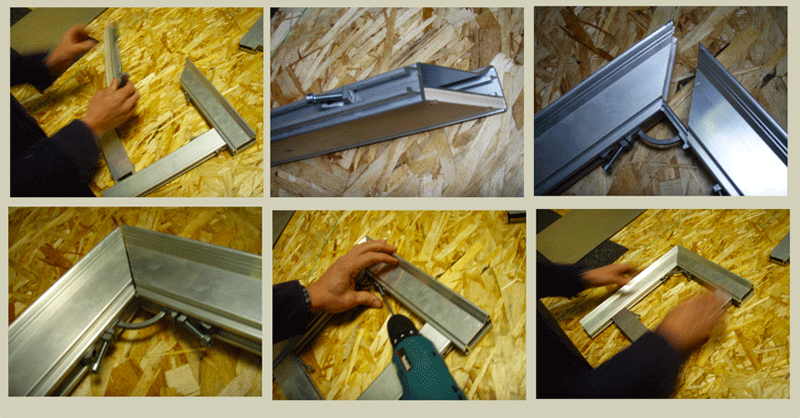
A perfect section. Each side has an articulated aspect with a job to do. Look at what Peter has done, the nuance of the design. The lips and rails and grabs and scribed notches. The thickness of the metal and the stout proportion in a careful ratio to support the knife edge in a canvassed tension.
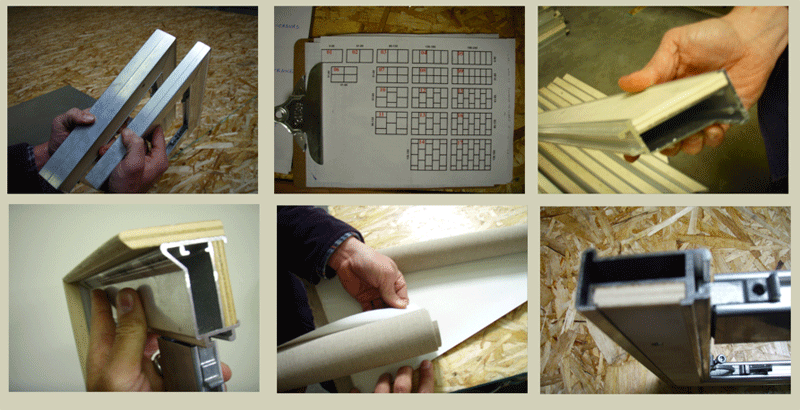
This assembly was designed for stretcher bars. I asked if it were possible to build a warp-proof support in a panel form. I was thinking of aircraft skin, maybe in plastic corrugated aluminum glued to the aluminum stretchers. (READ:$$$$) It turned out that luan sheets could do the trick with the existing design if you could shim them back onto the support. A bit of work.
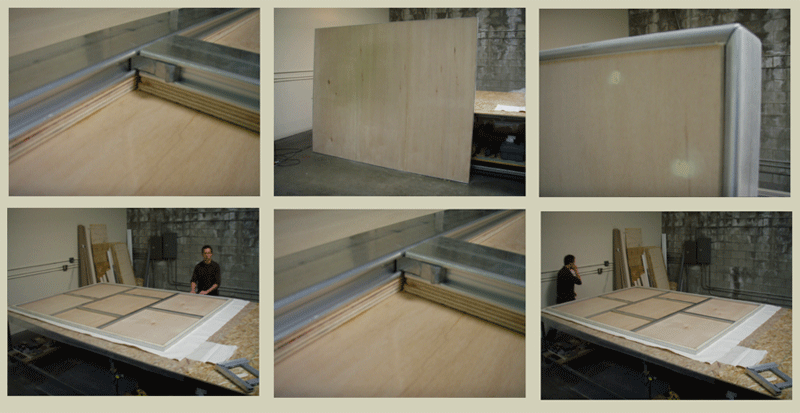
I visited Phil at Alustretch to check out the progress on the big panels.
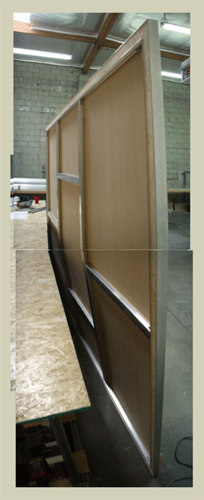
A Small Renovation
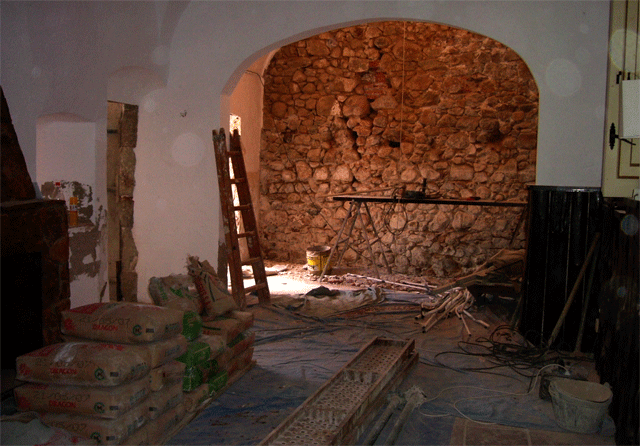
When we left Tossa last September, we met with Kiko and unleashed the hounds of home improvement that will transform our place profoundly. I hope. It will be a small enlargement of the patio and building in a simple country kitchen into one wedge shaped room that faces the courtyard. This will make our house there much more a house and much less than the former restaurant it was when it was Restaurante Tito's or the older incarnation as Can Marcelino.
Here are some pics that Kiko sent recently, let's start with a plan....
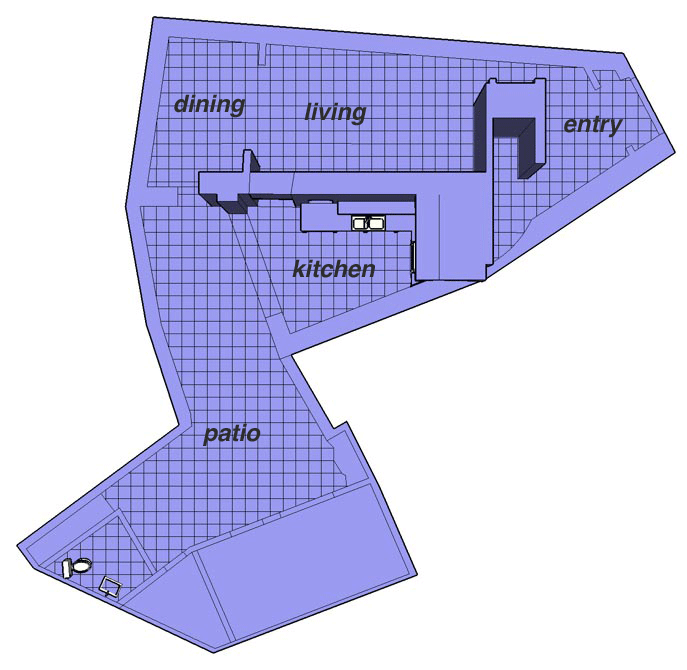
The original building was built as a cava winery in 1703 or 6 (Catalan champagne) and later a bodega famous with the locals, Can Marcelino. I imagine that it was when it became a restaurant that the additions of a bar and a kitchen was built out on the other side of the patio. Much like what we have done to our house in Echo Park, we restored the original form of the building, tearing out the nasty scrappy additions that encrust the structure in a bad way... like scraping barnacles off a ship's hull.
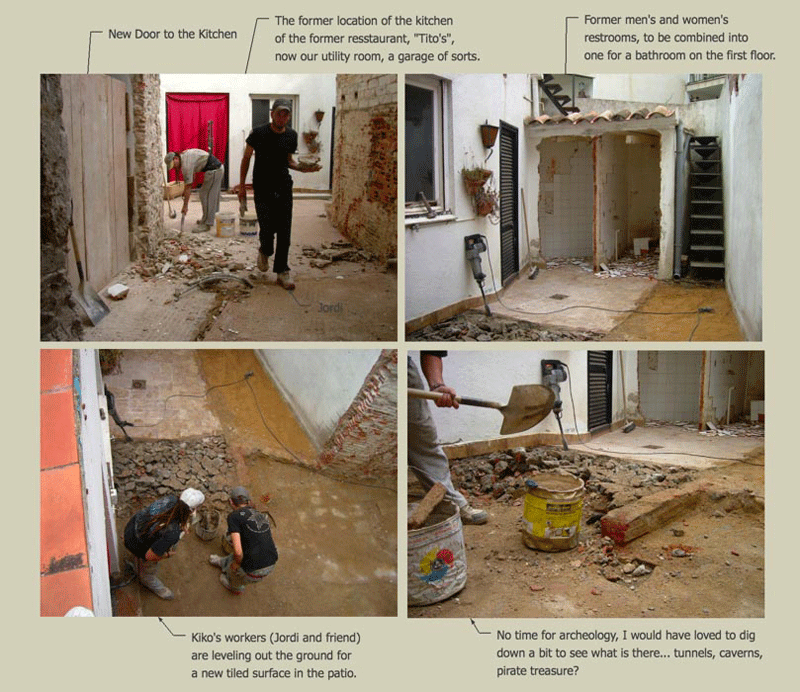

This is as it was when we moved in.
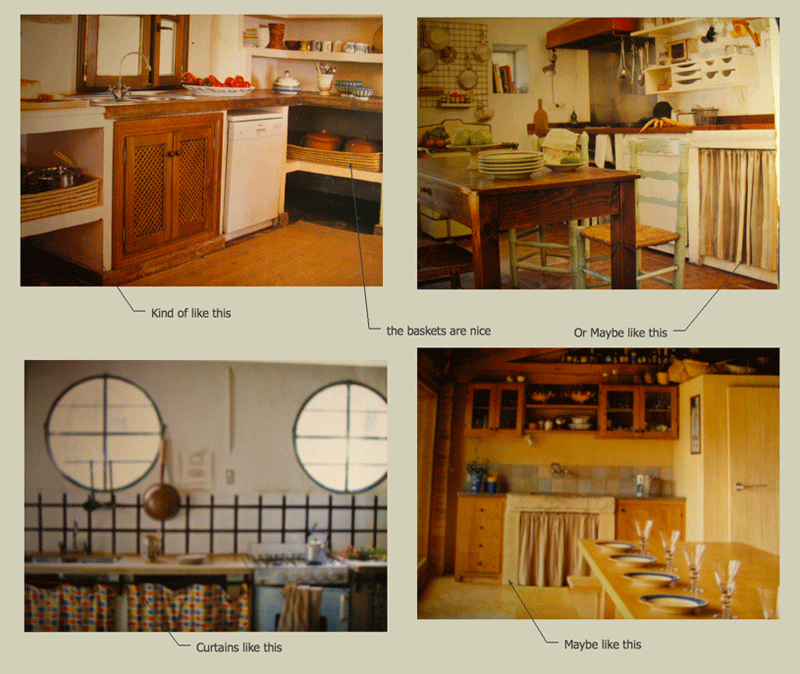
These are some tear sheets that describe a rustic kitchen, minimal and simple.
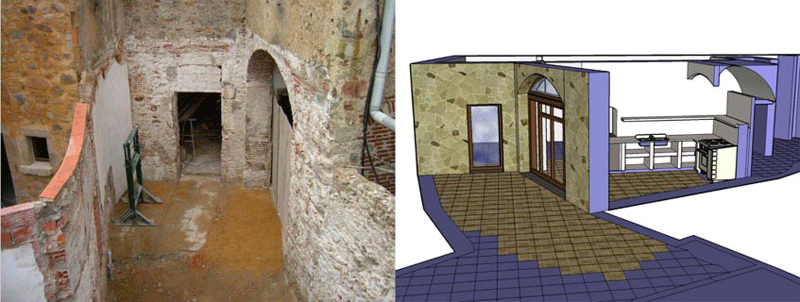
Here is where we want to go.
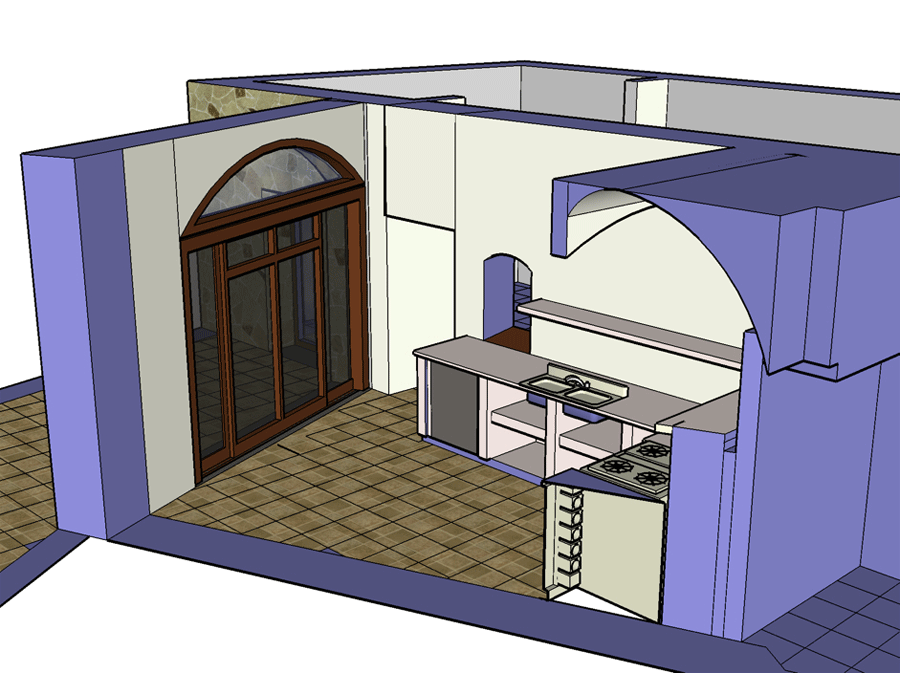
We want to take advantage of the strange existing geometry and bounce light into the arcing ceilings. Those ceiling arches are supporting the stair that begins to wind up above the kitchen. That big new glass door in that huge arched opening is going to be wonderful.

Kiko is repointing the grout between the stone in the massive south wall in the dining room. Already you can see how much more light that will pour in the ground floor. That should brighten the house up a lot. We want to set up lighting and hang something biggish on that wall, like a painting, maybe next year... I want to enjoy the stones for a while.
February 10, 2008
Something's Happening

Superdense days are here. There will be lots of posting on the fly, it's going to be rough. Fly is the word. Literally, I fly out to Spain this week for a week to see the ARCO art fair in Madrid for the first time. My gallery in Barcelona, Miguel Marcos, asked if I could come... como no? The city of my birth, I can check out the recent renovation to the PRADO (fingers crossed, I hope Raphael Moneo doesn't blow it) and I get to sample the famous night life there, yeah baby. Young Alberto will rendezvous with me there too. Cool.
After that I'll fly to Barcelona and bus to Tossa to see my pals there and the progress on the small renovation that we put to motion as we left last September. More about that later.
But before I fly out of LAX, there's this painting that I want to paint...
The Tour: Flowing, Pulsing, Beating, Burning
A quick visit to Roger Dickes' Glendale College Art Gallery and the show he curated / was generous to invite me into, Flowing, Pulsing, Beating, Burning.
*
*
*
Tough stuff, speed posting video and beating back the paralyzing self consciousness. My favorite part: Roger at 7:30 into the video.
Here goes...
BCAM

I'm not sure exactly why Ed Ruscha wanted to burn the LA County Museum of Art. But I sense a kind of boggy mire that must come from the inevitable bureaucratic entropy inevitably associated with the grand and otherwise distinguished cultural institution that is Southern California's civic crown jewel. Try as they might, there is always something... less than magnificent about the art complex that is LACMA.
Well, as I like to say: Bureaucracy is the natural enemy of art. (I've just added Penny Aphorism #12.) This must be the ultimate source of the creep of mediocrity that keeps LACMA from shining as bright as it otherwise should. "Good enough for government work!" Even with the monumental efforts of building BCAM (Broad Contemporary Art Museum), even one of the worlds truly great architects was eventually sucked into the muck of mediocrity which for me sadly calls to mind John Fante's famous line: ?you pretty town I loved you so much, you sad flower in the sand, you pretty town ...?
No wonder Eli Broad reserved the bulk of his collection for his private foundation museum.
(Eli Broad delivers opening remarks at the unveiling of BCAM, LA County museum of Art .)
I don't mean to strike a corrosive downer note over the feat and deed that is the manifestation of the museum "campus" (their term) of seven buildings, a prehistoric bog, a park and twenty acres. The harsh aspect of this critique arises from the laurels of achievement that LACMA has justly earned thus far and the ambition by which it is tasked. LACMA is a good museum and it has a destiny to be a great one. This is why it must suffer a ruthless assessment. I think of exemplars such as the Smithsonian in Washington and the Metropolitan Museum in New York and and I would guess that it is the overwhelming force of a 230+ year democracy or the immense powerhouse that is New York City that helps these institutions achieve such an august stature and overcome the shabby curse of bureaucracy. So let this temper the harsh edge of this critique: Los Angeles is young. (I think LA is like a New York before the subway was built.) Despite the fact of California's high ranking in economic terms, there has not been an earnest reinvestment into infrastructure both practical and civic since the late sixties. In terms of diverse public/private partnerships that include British Petroleum, Target and Credit Suisse who participated in the creation of the LACMA campus, it bodes well as a example of what can and should be done in Southern California in the near future.
The particular contribution of the Eli and Edythe Broad collection is remarkable indeed. It is in fact a transformation of suburban wealth (Broad's Sun America and KB Home are both in the Fortune 500) into an extensive urban philanthropy. Indeed, the specific collection that Eli Broad is known for is so well done that the only critique that remains is that it appears all too complete, too much of a last word on the subject. Specifically, it is too complete in the telling of the story of the arc of the era known as postmodern art from Warhol/Ruscha to Koons/Hirst, the art of the 80's.
(Perspective alert: I see the development of art from the eve of the 60's to today as a forty year arc where art's mandate was to indicate everyday life through conceptual means. #2)
Therefore I find the various controversies over what Broad should or shouldn't have done with his property and his responsibility to Los Angeles or to the art world at large too tedious to track. The whole event is a great feat and a good deed, and everyone deserves an "attaboy" as far as I can see. But I did have high hopes for Renzo Piano's contribution and it was sad to behold the mire of the bog that for me has come to symbolize the whole evolution of the LACMA campus.
(Renzo Piano Opening Remarks BCAM LA County Museum of Art.)
Initially, I fell under Piano's charms with the opening of the Twombly museum in Houston. Free of the partnership with Richard/Sue Rogers that created the remarkable yet garrulous Centre Pompidou, the Twombly museum seemed to me to reflect a kind of elegance of tech that was closer to aviation engineering. His expression of technological systems was tempered by Occam's Razor, nothing was designed that didn't serve the purpose of the building both functional and existential. The tech was hidden, even... the roof layer was a multitude, a bristling and vibrant machine whose presence was indicated only by the quality of light in the galleries and the occasional upskirt glimpse tastefully delivered. The rest of the structure seemed eternal. Overtones of Egypt. It appeared to be a promise of art history delivered in stone, concrete, proportion and stately procession.

(Click to pop up the parti.)
And Piano became famous for his parti: the eternal gallery and the tech frosting; the veritable sky, the kind of firmament that only pilots know, delivered in ambient presence within his architecture. So as I sat in the audience listening to the unremarkable opening remarks, I wondered about Piano's parti and how he would handle three stories of it stacked atop one another. I had hoped that the two floors weren't generic. But how could he have done it? How could one deliver one floor of galleries to the sky and deny that sky to the others below? There would not be any participation in this expression, no aire de Antoine de Saint-Exup?ry's, no Renzo magic below the top floor because the signature Twombly parti can only go so far... like a magnificent yet doomed jet in a high speed turn... before it disintegrates in mid air.
I was hoping to be surprised, another page in the Piano book.

(foto: Dan Hontz)
The first sign of trouble was the escalator to the third floor, the primary entrance to BCAM. Literally with the hum of people mover machinery, it was a solution chasing a problem that didn't exist in the first place. It was a massive poker tell of a bluff. Walking up into the entrance and down into the building, my fears were confirmed. The floors below were indeed anonymous architectural genera, the kind of architectonic blather one sees in office parks, shopping malls or somesuch building types. It was a copy and paste architecture, a formulaic draw from a pull down menu of anonymous solutions. Only the ceiling height and general proportions referred to a museum gallery. But to be fair, perhaps this is sufficient to the task. After all, these are the only qualities that artists tend to want in an exhibition space generated by architects.
Like the turn away from formal expression that architect Frederick Fisher made in the middle of his career --he said that he wanted to become a "merchant of light and space"-- this was a song sung to the hearts of artists all over the world. Artists and architects are famous for not liking one another, remember Robert Irwin's famous face eating scene with Richard Mier in the PBS special covering the creation of the Getty campus? Artists would prefer that architects get the hell out of the way, to not constantly steal the show, all the while stealing away a proper context for the presentation of art. Architects fundamentally don't understand why artists exist at all since it is architecture itself that is the mother of the arts... and mommy dearest isn't happy when the kids aren't quiet and behaving nicely. But Fred Fisher wasn't the architect of BCAM and Renzo Piano isn't a self effacing, ego erasing Buddhist. Piano can only get into trouble if he creates genera in architecture. Piano has a specific vision, and this vision suffers when it is not attended to.
And then there is the "spider".

With the repeated flaccid references by Piano and various LACMA officers to the "spider" that is the circulation spine of the campus, there seemed to be an attempt to convey some kind of affection for the internal street that culminated in the escalator. It was as if they had to convince themselves and the public that the crawling walkway was the string that strung pearls. The creepy crawly name itself, the "spider", betrayed a lack of trust in the expression of the solution. Spiders spin webs and spiders eat what gets caught in them. All the red paint with which the "spider" was painted seems to be another solution chasing a problem that didn't have to exist in the first place. Perhaps the expenditure of 60 million strained the budget. Of course it did. Perhaps the circulation should have had a more robust presence. Yes. Perhaps the spindly sticks of I-section steel actually reflect the literalness of the characteristic line hatches of Piano's drawing style. Hell, yea. It was as if he had handed off airline cocktail napkin sketches to his lead designers as he zoomed off to the next fabulous client meeting (I recall I.M.Pei's famous generation of the solution to the National Gallery in Washington while flying coast to coast). It might have been better to evoke an urban street using paving stone, lighting standards, occasional seating, trees, vistas, crossings, water features (...since I am continuing this blogpost after a visit to Madrid, the Paseo de Prado/Recolctos/Castellana is what I am thinking of). But then again, what would all this have to do with the tech frosting that delivers the aire de Antoine de Saint-Exup?ry's?
Thinking of how to express other architectural features outside of the classic Piano parti prompts me to wonder how Renzo Piano could possibly extend his language beyond the tech roof systems that he is so justly famous for. Architects see buildings in terms of systems much like doctors do, in terms of nervous, digestive, circulation, and endocrine systems. Unlike his contemporaries such as Foster Associates who emphasize the extreme expression of engineering systems such as mechanical, structural and electrical, Renzo Piano focuses on broad systemic categories such as roof, wall, floor as the principal aspects of architectural expression which would normally contain the three engineering systems. Specifically, he has dwelt on the roof as an empire in itself, one bristling with the various subsystems meant to deliver the lens of light in the sky into the interior volume of the architectural experience.
My question to Mr. Piano: why not look into the other broad aspects of wall and floor systems for a capacity to do something similar to what you have done with the a tech thickened roof? Wall systems could become a lens which focuses and delivers the civic community. Floor systems could become a lens which focuses and delivers the earth and ecological context. Perhaps it is his genius that restricts his expression to the sky. Perhaps it is the central distinguishing aspect that separates him from his former collaboration in the Centre Pompidou, a move that broke him away from general techno-lust that obscures thousands of other architects.
Therefore, in commissions such as the BCAM, it is important to negotiate the two forces that prompted him to stack his important parti atop two floors of genera: the need to enfront Wilshire Boulevard with an elevation that linked LACMA West with the rest of the Campus, and to clear the decks for the provision for underground parking and open green space that is the tattered remnant of the La Brea tar pits.

(Click and imagine spreading BCAM across the site like a hot butter knife.)
It's time to do our own design a la cocktail napkin. Let's imagine a Ranzo Piano solution that ties all these aspects together: A tall and narrow space that forms a facade on Wilshire, top that with a Piano tech frosting, flow the frosting in an angle to the north down toward the park and let that cover the rest of the program that is spread out over the former open space across the circulation spine, then tuck the parking under the whole program and then take the green space and feather that into the tech frosting in a way that merges people on foot into the Antoine de Saint-Exup?ry's firmament. Would it be possible to achieve a feeling of flying or floating as you approached the building from the park?
One can only wonder.
February 8, 2008
Ahora
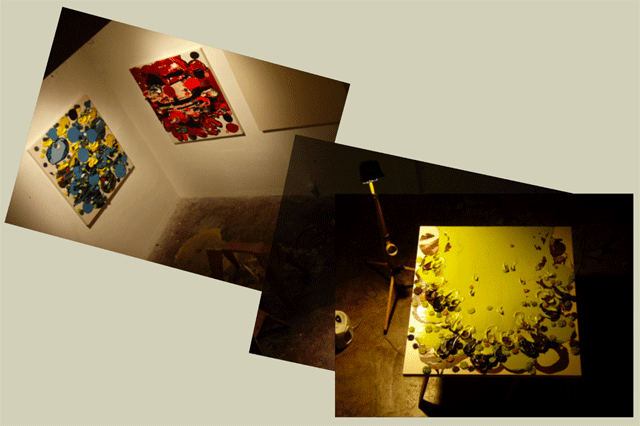
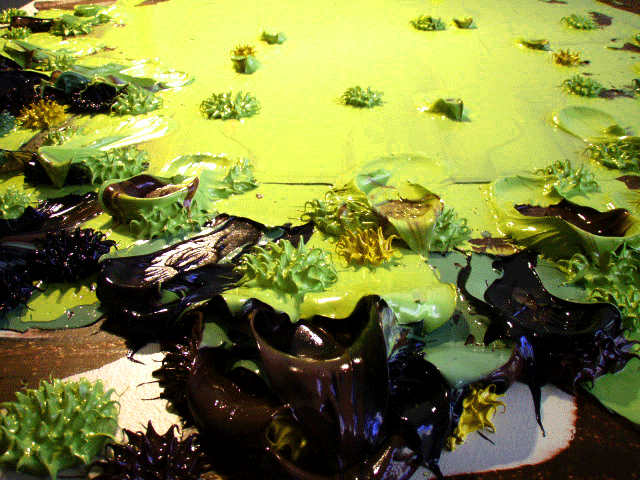
(I'm mashing King of a Sceptered Isle with the previous painting.)
February 6, 2008
About This Blog
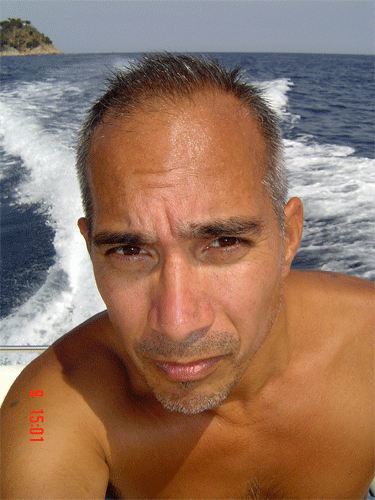
(Look. This is my serious face.)
This summer will mark an anniversary of five years of blogging and there must be some significance to the fact that it is only now that I'm finally coming around to formulating an explicit statement of purpose for this weblog.
One might think that such a statement would follow once people began querying my identity such as when Trevor of K'aleb?l Blog asked who I was. I responded by creating a timeline biography. I didn't want to plug in the regular biography/resume thing. My galleries have that for you if you want to see one.
People periodically kept asking me about the purpose of the blog as time went on. I wanted to keep the definition of it open as long as possible... but then conventions crystalized quickly and there are types emerging in the weblogging world. People seem to be wondering what kind of blog this was and when they didn't wonder, they seem to assume that this blog is like all the others.
This is my declaration of independence.
- I want to treat this weblog like a sketchbook. It is not a diary.
- This blog is not a career instrument, all appearances notwithstanding. Career stuff for artists should be learned and quickly forgotten.
- This blog is not a news aggregator. It's more like: "Hey, check this out..." It is a rough record of my curiosity.
- This blog is a way for my galleries, my friends and guests to visit my studio virtually. It is a way to keep in touch since I am so fortunately flung out around the world.
-This blog is a way to see the paintings in another light.
With cameras and stuff.
- This blog is a kind of bibliography for the paintings in the studio.
I have come to rely on the weblog for titles and reflections on or of content. My titles are hyperlinked. I like that very much. Such a practice unites the paintings, the blog and the life I reflect into the blog in a very interesting way... for me that is (#8). By doing so, I think I have both a less specific and a more specific relation to content and the ultimate signification of meaning in the paintings.
Sweet. (Head, nodding.)
- A blog is its' own art form. A literal -albeit virtual- expanded field.
It's the tip of the avalanche of the information age, its' conventions are evolving and to apply expectations as to what is a norm or standard of disposition of weblogging in general at this early date is either asinine or merely misguided. Text, photos, video, come what may and come it will, to be sure.
This blog is free. Gratis. Wild West. It is uncharted and even more boundless than our unregulated art world itself. It is outside that big, bad boogie-man called the marketplace. Hands clean of filthy lucre. It is wonderful that so far no one knows what to make of it and it is simultaneously a bit mystifying to me why artists at large haven't yet taken to it with gusto.
Trouble in paradise?
Pues, nada.
February 5, 2008
February 4, 2008
February 3, 2008
we are all lighter, physically and morally
There's a lot that I was compelled to clip in Jeremy Harding's review ofPraised Be Our Lords: The Autobiography by R?gis Debray in the London Review of Books. It's a pretty good review, a nice intro to the storied life of Debray. I'll tuck most of it below the fold and highlight the rim shots with bold text. the first part caught my attention because it resonated with a quote from a recent post: "...throwing stones at the people who would save him from drowning...":
That debt was easy to acknowledge. But in Chile, as Debray sent off his letters of gratitude to the French ? Pompidou was among the recipients ? he was forced to reflect on the fine line between contradiction and hypocrisy. Flying out to Cuba at Castro?s behest in 1965, he had rejected France entirely, wished it to hell even ? ?my family, my background, respectability, the state? ? like a conspirator lighting a fuse and stealing away, confident that every obstacle to a glorious future would shortly go up in smoke. Within a few years he was utterly lost; the very people he?d imagined closest to the blast were unscathed; indeed they were now busy dragging him to safety. Debray was put on the spot, though his thank-you notes were impeccable, like so many small gentlemen bowing stiffly to grandees at a society ball. He later grew to feel ?ashamed?, as he says in Les Masques, ?of my shame at the time?, however bravely he managed to conceal it.
Of the four principals in Praised Be Our Lords ? Debray, Castro, Guevara and Mitterrand ? Debray is perhaps the most intriguing. He looks briefly at the shifts that his own position has undergone over the years, and faces the contradictions, notably in the 1970s, when more than one position was occupied at the same time: ?Where Europe was concerned I now took an openly reformist line, and although I made my self-criticism conscientiously, I continued to preach revolution in Latin America.? Moments of good humour, at his own expense, are frequent ? and beautifully turned. Uninflected statements of personal truth are rare. The most revealing is a passage about living with self-hatred but failing to deal with the hatred of others: even if this began with the beatings in Camiri, what he has in mind are the frequent polemical assaults by enemies in France and Latin America. Yet Debray has a courageous, martial temperament, despising May 68 for its ?absence of human sacrifice? and regretting the rise of brittle ?humanist values?, with their basis in ?predominantly feminine ?life-affirming? mentalities?. Non-Westerners, he feels, know better; they are closer to ?the laboratories of truth? where ?hunger, insecurity, conquering faith and war? can be studied daily and peace is recognised for what it is: an interlude between states of hostility.The greatest passages in the book are about the men of power. Allende would qualify, if Debray hadn?t liked him so unequivocally. He had a photo of Che on his desk inscribed ?To Salvador Allende, who is going to the same place by another route.? ?We thought this meant ?to the revolution?, not ?to suicide?,? Debray remembers, ?an interpretation that would have seemed outrageous at the time.? Yet Allende took his own life in extremis, while Che gave his away. Debray?s view of Che is severe to say the least. There are the usual remarks about his enthusiasm for the ?corrective labour camp? in Guanaha in 1960 and how he brought whole sectors of the Cuban economy to a standstill when he was minister of industry. But Debray is thinking of attitudes as well as deeds: ?Che was not an angel blasted by a stroke of fate. He did not snatch his death: he had been incubating it for ten years.? He was ?far harsher and less sympathetic than his power-seeking elder. Less demagogic than Fidel, and much less democratic. The fine photographs by Korda and Burri have left us a sensitive dreamer, when in reality gentleness and kindness were not among his salient characteristics.? He would think nothing of sending ?an unarmed recruit to the frontline with orders to get a weapon from the enemy, using a knife or his bare hands?. He showed ?bad character? by threatening to put ?some honourable old combatant? in front of a firing squad as a deserter ?just for stumbling during an ambush and losing his rifle?; he was guilty of lunatic ?rigour? in condemning a hungry man to three days without food for stealing a tin of condensed milk. ?What a fertile misunderstanding it was, in 1968, turning that believer in no-holds-barred authoritarianism into an emblem of anti-authoritarian revolt from Paris to Berkeley.?
As ?the last messenger between the two companions in arms?, Debray is much fonder of Castro, an energetic Caribbean, open, radiating a ?tropical cordiality? more attractive by far than the ?melancholy coldness? of Che, the ?armed hermit?. Debray?s Castro has something of Zorro and something of Don Quixote; he is steeped in oral tradition ? hour upon hour of speeches ? but passionate about books, though in later years he reads nothing but history....
A starry eyed caudillo is still a caudillo after all.Doing away with his Cuban mentor is something Debray regrets. It was, as he hints, one in a series of compulsive killings on his part: ?Disaffiliate, kill the Father, acquire another, reaffiliate, kill again.? ...
Mitterrand?s ?short-range lucidity?, Debray argues, was not a compensation for his lack of an idea, since close up, as he explains, ?a bad point seems as good as a good one.? As for Mitterrand?s ?anti-intellectualism?, it ?had seemed to me to indicate courageous freedom of mind, leavened with dandyism and guile: really it expressed an allergy to deductive exposition, and I am afraid to the very idea of truth.? The verdict is harsh but so was the consequence. As far as Debray could see, Mitterrand?s presidency coincided with the hollowing out of the left in France. It became a clannish assortment of managers and opinion-chasers, clinging skilfully to power for 14 years, at great cost in terms of the ?philosophy? of socialism and what he describes as its ?soul?. ?And now,? he reflects, ?we are all lighter, physically and morally.? He agrees that it was part of a larger story unfolding far beyond the borders of France and that it may not matter; or that maybe it matters too much to him. ?There are churches for people worried about the meaning of life. Each to his own catechism.?
February 2, 2008
Flowing, Pulsing, Beating, Burning
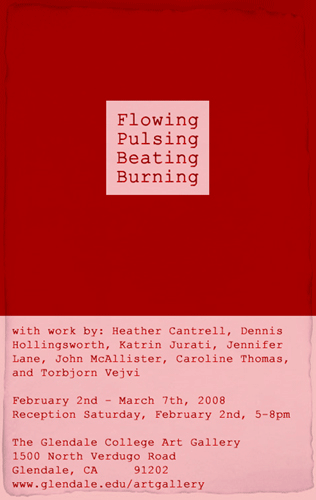
Roger Dickes presents a valentine of a show at Glendale College Gallery that opens tonight 5-8pm. I'm happy to be included and I am keen to see who is hanging with me tonight. Roger runs a cool program there. He's got an interesting history of curated exhibitions that positions him nicely on the ever shifting list of non-commercial spaces that an artist might want to show at here in Southern California.
Roger is an artist in his own right, actually. The rich potential that Roger has generated from an educational context positions him to do what others like him have done in the recent past: to move from the academic to the private realm (I'm thinking of Acu?a-Hansen in ChinaTown or even Randy Sommers of ACME).
I'm just sayin'.
For Immediate Release: Glendale, CA, January 10, 2008
Flowing, Pulsing, Beating, Burning, an art show opening at The Glendale College Art Gallery on February 2nd, 2008, invokes a discourse of blood, fluidity, and the animate life-force.? Artists in the show participate in these thematic categories through the individuated fusing of gesture and sign.? The pleasure of viewing the selected works together as a show may be in the varied eloquence of each artist?s interweaving of language and raw impulse, or in the seductive writhing and tension of the overall installation. Dennis Hollingsworth will contribute two paintings on paper, Torbjorn Vejvi will show one medium-scale sculpture made of metal and fabric, there will be two paintings on canvas by John McAllister, and eighteen framed drawings on paper by Jennifer Lane. At least one, maybe two large photographic prints will be presented by Heather Cantrell, Caroline Thomas will create two ceramic sculptures, and Katrin Jurati will create a large collage-based painting on silk.
The show opens February 2nd and runs till March 7th, 2008. A reception for the artists will be held on February 2nd from 5-8 pm. Admission to the gallery is free and all are welcome to the opening reception.
What if there were no punch lines?
Yesterday I was talking to a young artist, Jason Kraus about performance that renders objects and objects the render performance. He tentatively called it post-performance, and by I think that he meant to fuse a modern and postmodern intention, a strategy I am partial to.
In language that I like to use: if the modern was to touch G-d with material means and the postmodern was to touch everyday life with conceptual means, the next step forward can't be a simplistic post-postmodernism. But it might be possible to reverse the alienating mechanism within postmodernity and look for how antithetical worldviews interlock.
I can hear Bart walk by, muttering: "NERDS!". He's right . Enough of that.
Two items come to mind. Both are probably tangential to the conversation, but I'm happy to mention them anyway. They are about performance and how the unscripted open ended kind is the ultimate prize. The video above, here's the YouTube description:
Famous TV Director James Burrows talks about Andy Kaufman and his work on "Taxi".Insightful interview with a first hand account of the legendary Tony Clifton incident.and this great piece from the Smithsonian Magazine by Steve Martin:
In a college psychology class, I had read a treatise on comedy explaining that a laugh was formed when the storyteller created tension, then, with the punch line, released it. I didn't quite get this concept, nor do I still, but it stayed with me and eventually sparked my second wave of insights. With conventional joke telling, there's a moment when the comedian delivers the punch line, and the audience knows it's the punch line, and their response ranges from polite to uproarious. What bothered me about this formula was the nature of the laugh it inspired, a vocal acknowledgment that a joke had been told, like automatic applause at the end of a song.A skillful comedian could coax a laugh with tiny indicators such as a vocal tic (Bob Hope's "But I wanna tell ya") or even a slight body shift. Jack E. Leonard used to punctuate jokes by slapping his stomach with his hand. One night, watching him on "The Tonight Show," I noticed that several of his punch lines had been unintelligible, and the audience had actually laughed at nothing but the cue of his hand slap.
These notions stayed with me until they formed an idea that revolutionized my comic direction: What if there were no punch lines? What if there were no indicators? What if I created tension and never released it? What if I headed for a climax, but all I delivered was an anticlimax? What would the audience do with all that tension? Theoretically, it would have to come out sometime. But if I kept denying them the formality of a punch line, the audience would eventually pick their own place to laugh, essentially out of desperation. This type of laugh seemed stronger to me, as they would be laughing at something they chose, rather than being told exactly when to laugh.
February 1, 2008
lashon hara monger?
I've been following Luke Ford (caution: this site's a rabbit's hole) for a few years, a strange character who defies description. This Article does a great job introducing him, I highly recommend it. Those of us in the art world should know about him, not only for his bad/good coyote-like behavior that is resonant with artists like Martin Kippenberger or entertainers like Andy Kaufman but that, as you will see in this video, about 1:30 into it, Luke Ford is vectoring into the art world at this very moment. Can you imagine what fertile ground our art world(s) would offer to a person of his talents, after he ripped through the porn industry, LA's Jewish community and recently in LA's City Hall?
It was classic Ford, throwing stones at the people who would save him from drowning, which is a tale he tells often about falling off a pier as a child after throwing rocks at his sister and she coming to his rescue.
